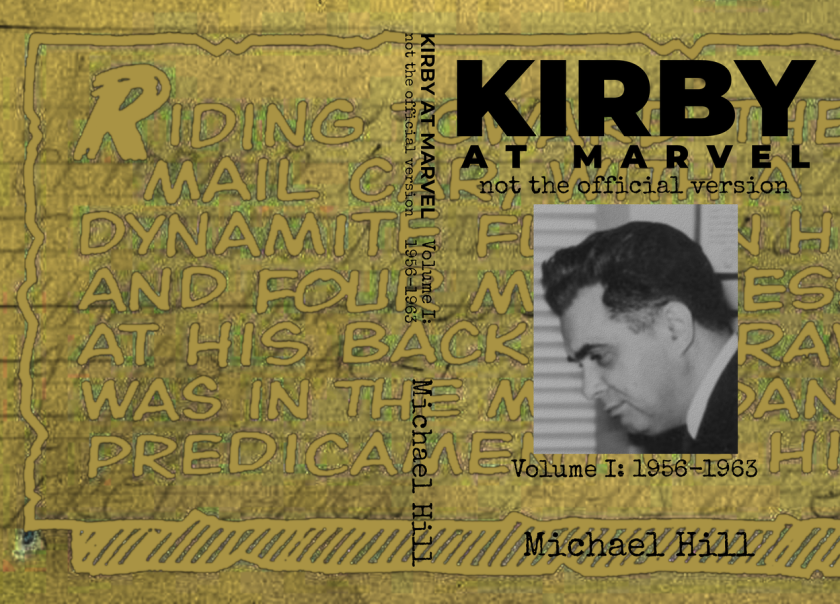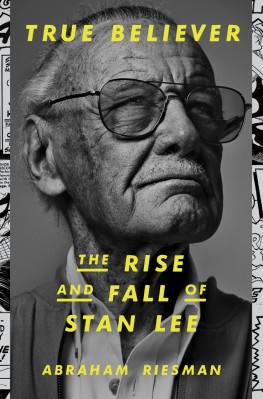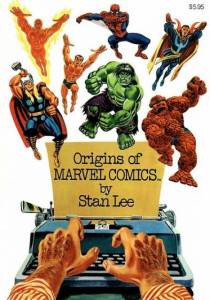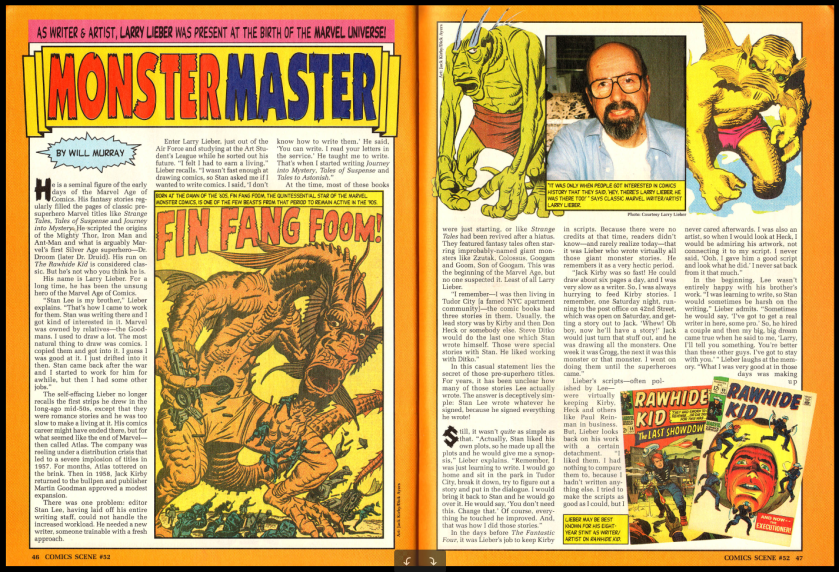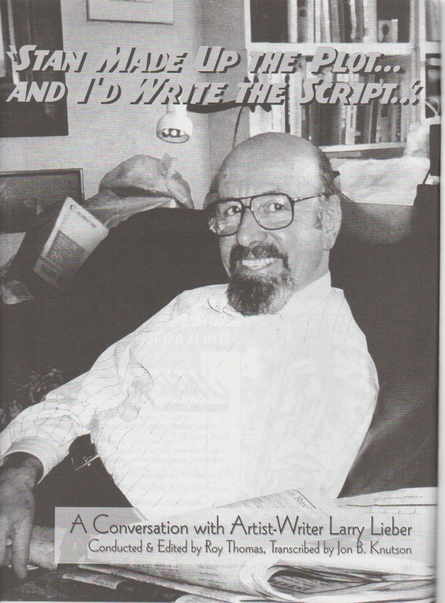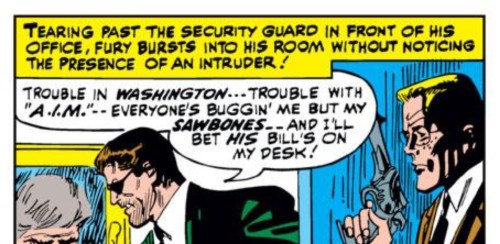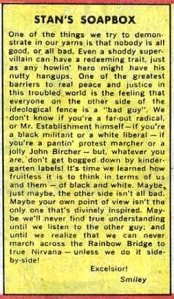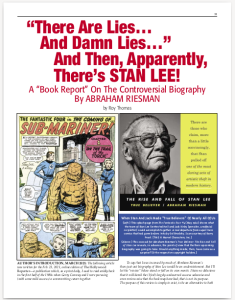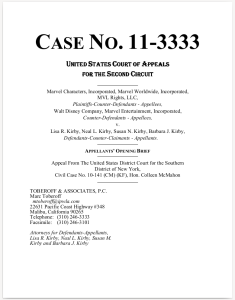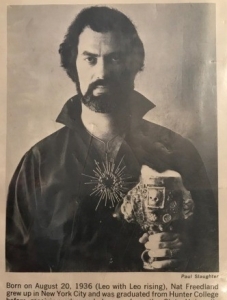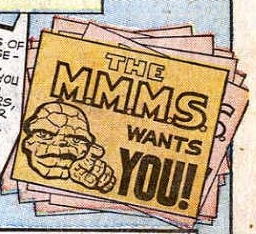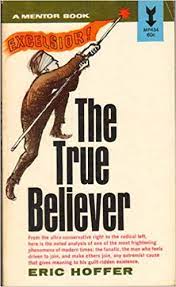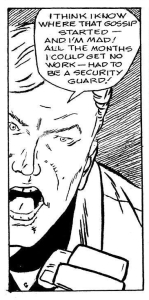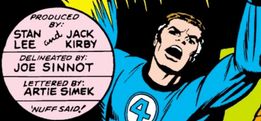 What wonders may be fashioned when mere humans put forth their inner strivings in joint effort. Listen, don’t ask me to dissect the human imagination. All I know is that we’ve all got one, and use it in a variety of ways. So, I write stories, okay?—Jack Kirby
What wonders may be fashioned when mere humans put forth their inner strivings in joint effort. Listen, don’t ask me to dissect the human imagination. All I know is that we’ve all got one, and use it in a variety of ways. So, I write stories, okay?—Jack Kirby
Jack Kirby was one of the greatest writers of the 20th century. Hope of recognition of that achievement in his lifetime was dashed by a fateful encounter in 1958. On the heels of a series of career setbacks, he crossed the threshold of the alcove of a man who was ashamed to be associated with Kirby’s chosen field, comic books.
The man in the alcove was Stan Lee, and he was in charge of assigning work to Kirby and the other freelancers. As with many such assignments in that industry and that era, the privilege of working came at a price: the kickback demanded by Lee and other editors. Concealing the wage theft that fueled Lee’s late-30s career reinvention required the enlistment of Roy Thomas and an army of cult members to conduct a disinformation campaign against Kirby that spanned decades.
Kirby was too literate for comics, but even that was taken away. Lee told the world that he was the one versed in the classic literature that inspired the creations.
To become a wall in this
cheap hovel is an ignoble fate!
Kirby’s ignoble fate was to have his writing ability demeaned by the likes of Lee and Thomas, two men whose added dialogue was called writing under cover of what Lee called the Marvel Method. They knew that their “writing” could only be considered good if they convinced people Kirby’s was bad. (Thomas proudly relates how he warned Lee not to let Kirby write upon his return in 1975. Now in his 80s, he pretends never to have learned the secret that the Marvel Universe was built on the writing of Jack Kirby.)
When Lee hatched the narrative of Marvel’s inception, he used his position at the company to cast himself in Kirby’s role as the creator and primary writer. Today this false narrative is everywhere, and can only be dispelled by spreading the story told by the freelancers.
The Witnesses
The Freelancers
His previous assignment dating to before the 1957 Implosion, Steve Ditko returned to Atlas at the same time as Kirby. He’s considered a reliable witness for a number of reasons. He was one of the few people who had direct contact with Lee during the production of the work, and the approach to history and politics in his writings has been described by Zack Kruse as “ethically consistent.” As a kind of reverse endorsement, none other than Roy Thomas cast aspersions on Ditko’s integrity: Ditko’s first-person historical account conflicted with the official version, and needed to be discredited.
One limit to Ditko’s knowledge is the fact that he only had contact with the other creators through Stan Lee, an unreliable conduit. Ditko was led to believe that Kirby’s working relationship with Lee was the same as his own, with Lee providing a synopsis after a story conference. The reality of the situation was that Kirby supplied Lee with the plot ideas that Lee passed on to Ditko and others.
Wallace Wood was the first Marvel writer/artist to be advertised on a comic’s cover. When he objected to doing Lee’s writing without credit or pay, Lee took away his penciling assignment and reduced him to inking pay. Wood was forced to seek paying work elsewhere.
Other freelancers who, decades after the fact, took issue with Lee taking the writing pay include Stan Goldberg and Dick Ayers. Don Heck gave us a glimpse his part of the elephant.
Roy Thomas
Roy Thomas, a former Marvel staffer in the position of historian as the editor of Alter Ego, is given more credence than the freelancers. Some of them were present when the Marvel Universe came into being; he wasn’t.
From what little I
heard talking to
Stan and Sol Brodsky
Thomas’ history is limited to the company perspective. In 1997, he revealed to Jim Amash precisely how he sourced his knowledge…
Thomas was the target of Kirby’s genius for caricature, and despite his denials he acts as though motivated by a deep resentment. It was Kirby who was primarily responsible for creating the Marvel Universe and keeping open the doors of the outfit that eventually employed Thomas, but in Thomas’ version of history, Kirby was guilty of “delusions of grandeur.”
Larry Lieber
With many hours of interviews with Larry Lieber for his Lee biography True Believer: The Rise and Fall of Stan Lee, Abraham Riesman has shone new light on the relationship between Lee and his younger brother. Estranged at best, Lee assumed little to no responsibility for his brother’s well being, despite the nepotism instrumental in his own career. In his 2011 deposition in the Marvel-Kirby case (the Kirby family applied for copyright reversions on a number of Kirby’s characters and Marvel sued them to prevent it), Lieber disclosed that he was testifying under threat of being stripped of his sole income by his older brother.
To Lee, his brother was a tool in the decades-long campaign he waged to defraud Kirby of credit. Beginning in Origins of Marvel Comics, Lee claimed for over twenty years to be the writer of Kirby’s late ’50s “monster” stories. Kirby refuted the claim in an interview in the The Comics Journal in 1990; his death a few years later provided an opportunity for Larry to do something for his brother. In 1995 Lieber was pressed into service as the stories’ secret writer, no evidence visible or necessary.
The True Believers
Such is the power of a prestigious public spotlight and blind faith.—Steve Ditko
Stan Lee wrote for an audience of children. He didn’t understand the principles of storytelling the way Kirby did, so he dismantled the stories. He adjusted Kirby’s work for that perceived audience, writing down to them in a way that Kirby never did.
Having served in the US Army Signal Corps during WWII, Lee was aware of the power of propaganda. If it could ever be said that he had read a book, it would be Eric Hoffer’s The True Believer: Thoughts on the Nature of Mass Movements (1951). Being strictly a magazine reader though, his exposure to the book likely came by way of a 1956 Look article.
Lee saw no difference between writing comic books and selling them, and he became superhero comics’ most celebrated writer by being their most devoted pitchman… Lee addressed the reader as a smart consumer, generating brand awareness and promoting the idea that one book’s success ought to rub off on another. The reader was told that appreciation of (read: purchase of) this comic placed him/her in the in-group of hip-talking cognoscenti. The direct address of the line implied that the reader was already a member of the group, a “pilgrim,” cool enough to enjoy this comic. Flattery like this got Marvel everywhere.—Darcy Sullivan
Lee created a cult and called them true believers: he played on their self esteem, and they became his army. He convinced them of something he didn’t believe himself, that reading comics was for cool, smart people. It became an enduring myth.
Another myth Lee cultivated was that true believers were older, college-age. He convinced even Will Eisner, who tried to foist it on Phil Seuling in an interview.
EISNER: Well, that was when Stan Lee developed a kind of connection with the “college market.” He produced the…
SEULING: …Pseudo-intellectual market [chuckle]. Grant Stan Lee that he sounded his market and fed it properly. I can’t go along with a lot of the propaganda that it was for adults, the Einsteins, the future Nobel Prize winners of the world. No, no, this just isn’t true. The mass market was still the 10-year-olds that kept plunking down 12 cents for a comic book.
The current generation of true believers sees Lee as the benevolent creator. They side with the company, management, and the characters over the real creators.
Stan Lee
Not all who knew Stan Lee were as enamored of him as the true believers.
Stan Lee has been positioning himself in the public consciousness as the living embodiment of the Marvel spirit for so long now he’s actually managed to make people believe in his megalomaniacal view of history. The fact of the matter is that Lee had a lot less to do with the vaunted “Marvel Philosophy” and the revolutionary Marvel approach to comic books than either Jack Kirby or Steve Ditko. It was Kirby who created unworldly epics in Fantastic Four and it was Kirby who spun morality tales in Captain America. It was Ditko who made Spider-Man the “everyman” comic book and it was Ditko who created the unmatched fantasy in Dr. Strange.—Joe Brancatelli
Well, Stan was tall, skinny. And the shyest person I had ever met up until that time. He would not talk to anyone. He’d hole up in his back office… That shyness. He was very supercilious. He was way above all of us. I think Martin Goodman looked down on him. I intuited that. So I think, in a sense, Stan kicked people below him.—Daniel Keyes
[Lee]’s like a dictator who orders great art to be destroyed because he does not understand it, but vaguely suspects he is being made fun of.—Chris Tolworthy
I was delighted to learn that Lee has attained the status of an authority in the comics field. Twenty years of unrelenting editorial effort to suppress the artistic effort, encourage miserable taste, flood the field with degraded imitations and polluted non-stories, treating artists and writers like cattle, and failure on his part to make an independent success as a cartoonist have certainly qualified him for this respected position.—B. Krigstein
I want the credit (and the money) for everything I do! And I resent guys like Stan Lee more than I can say! He’s my one reason for living… I want to see that no-talent bum get his…
—Wallace Wood
Jack Kirby always had the clearest view of his former teenage assistant. In this case he pegged it: Lee was a man without empathy.
…my wife was present when I created these damn characters. The only reason I would have any bad feelings against Stan is because my own wife had to suffer through that with me. It takes a guy like Stan, without feeling, to realize a thing like that. If he hurts a guy, he also hurts his family. His wife is going ask questions. His children are going to ask questions.
—Jack Kirby
1961 began badly for Stan Lee, as his newspaper strip, his tether to a career outside of comics, was cancelled. On top of that, his cousin-in-law-publisher yet again threatened to shut down the comics division. Jack Kirby had presented his stack of concepts to Martin Goodman, and they were approved one-by-one for publication. Acting out of desperation, Lee started experimenting with signatures and credits to justify his taking of the writing pay. As Lieber described it, when Lee saw that Kirby’s “strips” had potential (i.e. Goodman approved them), he started “writing” them.
Did Stan Lee do nothing? No. Did he do what he said he did? No. Never an idea man, Lee solicited story ideas from his readers, and used ghostwriters throughout his career. His witness to these events was tainted the moment he decided to take Kirby’s writing pay.
Jack Kirby
Following in the footsteps of the Beats, “serious” artists and writers first vilified and then celebrated the bottom strata of American culture. Comics were certainly near the very bottom, but they got their Charlie Parker, their John Lennon, in Jack Kirby. Were it not for Kirby, there would have been no Marvel Age.—Darcy Sullivan
Jack Kirby was a man compelled to tell stories through his chosen medium of comic books, a field he was too good for. His part in the creation of Marvel is evident in his words, in his interviews and in his margin notes.
As witness to the events, Kirby was there. As an expert on events in which he participated, no one was closer. Kirby’s account is the historical record; with Lee gone, only Thomas, Marvel, and the true believers remain to suppress it.
A Brief History of the Official History
In his “review” of Riesman’s True Believer, Roy Thomas coined a term. The received history is that which shall not be questioned, the version of events that will be defended to the death by the true believers. It was comprised of various propaganda blitzes in which Thomas was instrumental, serving to falsify the events of the ’60s and the late ’50s. Ultimately its goal was to fabricate a sanitized legacy for Stan Lee (and by extension, Thomas) that left his stolen credits intact.
The received history was developed in stages. In 1961, Lee embarked on a scheme for partaking in Kirby’s page rate. Thomas started with the company in 1965, so this is the only stage for which he was not present and has no first-hand knowledge.
The month after the on-sale date of Fantastic Four #1, superfan Thomas had a review of it printed in Jerry Bails’ Comicollector. He wrote that the book stood “somewhere between the Challengers and the new Justice League of America.” The Challengers of the Unknown were Kirby’s ground-breaking and much-imitated team for National which was itself inspiration for, among other things, the JLA revival. The Thomas review is the origin of what would become “the JLA story,” missing (by about six months) the events that the story purports to describe.
In a 1963 letter, Lee told Jerry Bails that Steve Ditko had created Dr Strange on spec. Lee didn’t have much faith in the character’s sales prospects.
In January 1966, Lee and Kirby were interviewed by Nat Freedland for an article in the New York Herald Tribune. Lee put on a show, jumping around and physically acting out an upcoming Fantastic Four story, ostensibly “writing” it on the fly for Kirby to “draw” later. The readership had taken notice of Kirby’s choreographed fight scenes, and Lee wanted credit for their conception. Freedland’s published article exaggerated Lee’s contributions to the work and made Kirby look like an oaf. In an interview for True Believer, Freedland admitted to Riesman that he’d been angling for Lee to give him a job.
In 1968, Perfect Film & Chemical purchased Marvel. Having padded his résumé with Kirby’s accomplishments, Lee was perfectly positioned to assume the mantle of creator of everything. This suited the new owners because Lee had been on staff when the creating was done, mitigating any intellectual property concerns.
By the same year, Lee worship was already recognized as a problem in one of the Marvel-specific fanzines. Between 1968 and 1974, a narrative was established to cover Lee’s fabricated credits, culminating in Origins of Marvel Comics under his byline.
Origins gave us the JLA story, in which Martin Goodman allegedly saw competitor National’s sales figures for The Justice League of America and told Lee to come up with a superhero team. Roy Thomas could have ghostwritten this bit, simply recycling his 13-year-old review of FF #1. The Origins version strategically omitted Thomas’ earlier mention of the Challengers, which tied the FF to Kirby’s earlier work.
Kirby’s published interviews date back to the late 1960s. The one conducted in 1989 by Gary Groth, published in The Comics Journal in 1990, struck a nerve. Lee intimated in Origins that he’d had a hand in producing the monster stories, a claim Kirby refuted in the interview. This prompted Lee to begin formulating a propaganda counterattack that would take years to coalesce. For starters he lashed out, telling an interviewer that Kirby was either evil or crazy. He then reasserted his false claim to having written the stories in a “Soap Box” and a reprint introduction.
In 1994, Kirby died; the following year, Lee redirected his attack. Larry Lieber was introduced as the (uncredited) provider of full scripts to Kirby for the monster stories, based on Lee’s plots. Upon examination, it becomes obvious that the plots were Kirby’s from his (already written) finished pages; Lee was simply passing the plots along to Lieber. In his 2011 deposition, Lieber admitted he would turn in the scripts to Lee, and had no contact with a prospective “artist.” Kirby had no need of a Lieber or Lee script for a story he’d already written and dialogued himself.
There were no credits on those stories, although many were signed on Kirby’s behalf by Dick Ayers. Kirby was assigned his first in the spring of 1958, and the first credit boxes appeared in in December 1962. As an indication of when it first became important to Lee, 1973 monster reprints were retrofitted with credits for the first time. Lee was added as writer; Lieber didn’t rate a mention. Lieber failed to include “writing full scripts for Jack Kirby” in his 1975 Atlas/Seaboard CV, something that would have been a highlight of his career at that time.
You know something, Roy? Now that you say it, that’s probably true.
—Lee, signaling that Thomas is making it up
In 1998, Lee was fired through Marvel’s bankruptcy proceedings, and Arthur Lieberman became a visible presence at his side. In Comic Book Artist #2 and the Alter Ego on its flip side, Roy Thomas swung into action providing much of what we know today as the early history of Marvel. Lee was quoted as saying “That’s absolutely true” about a story that was absolutely false.
In 1999, Michael Vassallo proved that Lee originally had no intention of being involved in Kirby’s monster stories other than through his staff position as editor. Lee’s signature was his mark for staking his claim to credit for “writing” something, whether that claim was valid or not, and he hadn’t signed a single one. Instead of science fiction or suspense, he stuck with his strengths: the teen humour titles and westerns.
When Thomas interviewed Lieber for Alter Ego the same year, Lieber maintained the full-scripts-for-Kirby charade, but an incredulous Thomas interpreted it as adding dialogue.
Finally, in a 2010 deposition in the Marvel-Kirby case, Lee, with Lieberman again at his side, laid claim to sole creatorship of every property for which the estate had applied for reversion of copyright. After the Kirbys commanded a steps-of-the-Supreme-Court settlement from Marvel, Lee and Thomas doubled down on their false history.
The Marvel Method
The Marvel Method was a kickback scheme. Stan Lee spun it as giving his “artists” freedom, keeping them busy while he wrote stories for more than one at a time. The reality is he was taking the pay for writing that was already done when he received the pages, and in exchange he would deign to give his writer/artists further assignments. Lee didn’t plot and he didn’t write scripts, but he frequently mandated changes to stories after the penciled pages were turned in.
Lee never wrote a full script for any work I did at Marvel.—Steve Ditko
I had no script. [At Marvel] I was never given a script.
—Jack Kirby
Daniel Keyes:
WM[Will Murray]: Stan Lee is today considered one of the great comic book writers. Was he writing many comics in those days?
KEYES: Not to my knowledge. He edited, I guess. He was a businessman, as far as I was concerned. And a shy businessman is almost an oxymoron. I’ve never thought of Stan as a writer at all. So that surprises me. Of course, he might have been turning in comics for a few extra bucks, doing it under pen names so that Martin Goodman wouldn’t know about it. I never thought of Stan as a writer. He says that he created Spider-Man. I never thought of him as a creative person. It could be that one of the writers created it and sent in a synopsis. And it got picked up. But of course he’s become a multi-millionaire for that stuff.
Stan Goldberg:
One time I was in Stan’s office and told him, “I haven’t got another plot [for Millie the Model].” Stan got out of his chair, walked over to me, looked me in the face, and said very seriously, “I don’t ever want to hear you say you can’t think of another plot.” Then he walked back and sat in his chair. He didn’t think he needed to tell me anything more. After that, I could think of a plot in two seconds.
JA[Jim Amash]: Sounds like you were doing the bulk of the writing then.
GOLDBERG: Well, I was.
Dick Ayers (as reported by Barry Pearl):
Dick told us how Stan called him one day and said, “I can’t think of a story for Sgt. Fury #23. We won’t have an issue unless you think of something!” A worried Dick could not sleep that night and kept Lindy awake too. They talked about story after story until, in the middle of the night, Lindy came up with the idea of the Howlers saving a nun and her young charges. Dick said, “Stan will never go for that, he wants nothing about religion… But I’ll ask him.” When Dick did, Stan said, “What a great idea, I’ll use it.” So they put together a terrific story. When Dick’s finished pages were shown to him, he saw the credits where he was only listed as artist. He went to Stan’s office and asked if he could also be listed as co-plotter. Stan yelled, “Since when did you developed an ego? Get out of here!”
Wallace Wood:
I enjoyed working with Stan on DAREDEVIL but for one thing. I had to make up the whole story. He was being paid for writing and I was being paid for drawing but he didn’t have any ideas. I’d go in for a plotting session and we’d just stare at each other until I came up with a storyline. I felt that I was writing the book but not being paid for writing.
Conventional wisdom, disseminated by popular scholarship and the leading Kirby fanzine, says Lee did more plotting and writing in Marvel’s early days, until his “artists” developed their own plotting abilities. If he was leaning on Goldberg for Millie plots and Ayers for Sgt Fury, it is simply not believable that he ever supplied Kirby and Ditko with plots. A cursory glance at the early issues of Amazing Spider-Man shows us that the title subsisted on Kirby plots until Ditko took over with ASM #3. The physical evidence shows that Lee didn’t plot, but solicited or appropriated ideas throughout his career.
The disinformation campaign
And if all others accepted the lie which the Party imposed—if all records told the same tale—then the lie passed into history and became truth.
Early in the FF letters pages, for his audience of children, Lee jokingly accused Kirby of greed. Projection became one of his tools for dealing with the degree of insubordination that might be expected from victims of wage theft.
Considering that our artist signs the name JACK KIRBY on everything he can get his greedy little fingers on, I think we can safely claim that that’s his name!
Lee was the one who signed everything he “wrote,” including the paper doll pages in the teen humour mags. His titles were being squeezed out by the sf books, and when Martin Goodman gave the green light to Kirby’s team concept, Lee signed on to the project: on the splash pages.
Kirby didn’t sign his own name to his work, but when Dick Ayers inked, he signed “Kirby+Ayers.” Lee, in addition to putting his name on work to which he hadn’t contributed, began painting out the Kirby+Ayers signatures. He perceived that they gave the (correct) idea that he wasn’t involved, or that Kirby might have been the writer (also correct).
By the ninth issue of Fantastic Four Lee was taking the “script” credit and giving Kirby an “art” credit. In the eleventh issue, he wrote on the letters page, “Stan Lee writes the stories and Jack Kirby draws them.” Credit boxes replaced signatures as the outward reflection of Lee claiming the writing page rate for the work of Kirby and his other collaborators; they were bound to accept the situation or lose future assignments.
A few years later, Lee repeated his letters page shenanigans with Wood. In a display of petulance that gives perspective to the company view that Kirby’s Funky Flashman was “unprofessional,” Lee tore Wood apart in the editorial pages in front of the same audience of children.
Not Stan’s fault
Abraham Riesman, True Believer: The general public is typically aware of only one narrative of the Marvel revolution, and that is Stan’s. His can be summarized pretty simply: “Stan came up with all the characters, plots, and dialogue; Jack just came up with the visuals.”
Roy Thomas, Alter Ego: Actually, if the “general public” knows only the version of events that Riesman paraphrases above, that’s hardly Stan’s fault. First, it’s because the “general public” never read the many, many places in the pages of Marvel’s 1960s comics wherein Stan praised Jack Kirby’s contributions to the skies, often giving him credit for what amounts to co-plotting stories, and on occasion even saying that Jack was likely to come up with a particular story all on his own.
“Not Stan’s fault” is a common theme in Thomas’ retelling. It’s “not Stan’s fault” that everyone believes he’s the creator, plotter, and writer; if only he hadn’t constantly portrayed himself that way, and had corrected interviewers whenever they got it wrong. At odds with “not Stan’s fault” are his 1987 interview comment, “the characters’ concepts were mine,” and his 2010 deposition wherein he claimed credit for every creation. It is entirely “Stan’s fault” that Kirby, Ditko, Wood and others didn’t get paid for their work.
The “artists”
Lee is praised for giving abundant credit to his “artists,” but that was part of the strategy. His collaborators were also creators and writers, so telling the world they were his artists was a calculated move.
Lee is said to have made his supporting cast famous. That might have been the case for some of them, but it was Kirby who’d made Lee famous. Kirby should have come out of the decade recognized as the industry’s top creator/writer/artist, yet his 1970 page rate was no different than Marvel’s or DC’s top non-writing artists.
Lee often said Kirby was very creative, but never credited him with creating a copyrightable property. Kirby was called a great plotter, but he never received a plot credit; Lee generously bestowed plot credits on many (particularly himself), but never the actual plotter. Lee gave himself a plot credit in places where it’s obvious his only involvement with a story was adding the credits.
Kirby was content to call himself the artist. Each time Lee (and later Thomas) used the word, however, it was designed to diminish a writer/artist’s contribution and plant the idea that Lee was doing the writing.
Evil
When Kirby’s interview for The Comics Journal was published in 1990, it exposed Lee’s happy bullpen as a façade. Lee had always made tactical use of spreading rumours about collaborators who had rejected his working conditions, and this time he didn’t disappoint.
“Some of the things [Jack] said, there is no way he could ever explain that to me. I would have to think he’s either lost his mind or he’s a very evil person.”
As with his greed comment, the worst accusation Lee could imagine was dictated by self-knowledge.
Kirby couldn’t write/Kirby needed a collaborator
The contrived narrative that Kirby could not succeed on his own was best served by redirecting credit for the stories he wrote. Kirby’s “monster” stories that kept the comics division from closing in the late ’50s were thus retroactively credited as a collaborative effort.
Since Lee’s death, Thomas is in charge of the false historical record. He simply ignores the physical evidence and repeats the talking points of the “received history.” The greatest insult he can imagine about Kirby’s writing is to say he didn’t understand it.
The true believers continue to echo the mantra that Kirby couldn’t write, but for those weened on Lee’s kiddie fare, Kirby’s writing is simply over their heads.
Jack Kirby’s writing was “Opera” at DC and if you don’t understand what I mean, no amount of explaining will change your mind. Every Saturday morning in my early years assisting Russ Manning at his Mojeska Canyon studio we would listen to the Met Opera broadcasts on Radio. Russ told me to understand that opera was very similar to comic books: Larger than life happenings, plots, character reactions…on stage in song like the pen and ink going-on of comic books. Okay… I’ve oversimplified…but it made sense to me! Jack’s 4th world writing was operatic. If there are a lot of you who don’t “get” what Jack was doing I am sad for you.—Michael Royer
What a lot of people don’t get is Kirby’s level of SOPHISTICATION–his work is full of allusions to other literary works. Your reading is enriched if you already know who Isaiah or Daniel or Caliban were. If someone doesn’t get it, it’s a knock against them, not Kirby.—Darrell Epp
Kirby’s writing is rife with bizarre word play, clichéd and surreal dialogue, awkward appropriations of youth-culture lingo, and entirely invented slang and technological argot. While charged with giddy momentum, it is not humorous in the knowing “camp” way that typified so much of comic writing in the wake of his early sixties work (and its translation into TV dialogue on Batman ). Instead, Kirby’s writing is riddled with the kind of rollicking unconditional humor that animates the work of Charlie Chaplin or Ornette Coleman: lyrical, sentimental, and revolutionary… It was in his collaborative books with Lee, however, that Kirby’s dominance becomes clear, as Lee’s trademark coldwar huckster bombast falls increasingly short of the expansively democratic and accelerating mystic vision that possessed Kirby.—Doug Harvey
Kirby also gave exquisite voice to ordinary people, hitting his stride in his ’40s and ’50s romance stories and unpublished teleplays. In 1970, after shaking the restrictions of Lee’s limited imagination, he picked up where he left off. Spectacular but unrecorded sales of Kirby’s DC work resulted in its demise, but again, misinformation, this time about the beginnings of the direct market, plays into the anti-Kirby narrative.
For many years, Stan Lee has taken sole credit for the creation of Marvel’s best-known characters. Lee underscored his claims in his book, Origins of Marvel Comics.
“That’s his version of it,” Kirby observes. “If he wants to say that, it’s his book. If I write my book, you’ll get my side of it. But I can tell you that my side of it is the real side—Stan Lee never created a character. In fact, if you look it up in Maurice Horn’s book, he was amazed, too. He was amazed at the kind of things that came out of Marvel after I got there and the fact that Stan Lee had never created a character before that. What has he created since? Nothing. I don’t think that Stan Lee cares about creating characters. That’s my professional opinion. But as far as writing the stories is concerned, he never wrote the stories—not mine anyway.
“I was a penciller and a storyteller and I insisted on doing my own writing. I always wrote my own story, no matter what it was. Nobody ever wrote a story for me. I created my own characters. I always did that. That was the whole point of comics for me. I created my own concepts and I enjoyed doing that.”
Lee rewrote Jack’s captions and word balloons when he brought the artwork into the office.
“Lee wouldn’t let me put the dialogue in. I wrote the story and made up the characters. I had to tell Stan Lee what the story was going to be. He didn’t know. Nobody’s ever seen Stan Lee write a story. I’ve never seen him write a story–not in front of me. Stan was an editor. I argued all the time about doing the word balloons, but I wasn’t allowed to do them. Stan Lee was editor, and his cousin was the publisher and I wasn’t going to argue with that…”
—James Van Hise, “A Talk with the King”
For three years, Lee stayed out of Kirby’s way and let him save the company. When it became evident that Kirby had the writing pay to show for it, Lee took measures to appropriate the pay and credit. The ensuing nine years were the low point of Kirby’s career.
The first step in getting to the truth is to disregard the constantly-changing Lee narrative as well as the received history. Jack Kirby is still the most reliable witness to the creation of Marvel: with his interviews and margin notes, he provided us with an outline for his book. With the help of his words, the view of the freelancers, and the physical evidence, the true story behind Marvel’s origin will continue to emerge.
Next: 1958-1960
Endnotes
“What wonders may be fashioned…” Jack Kirby, introduction, The Kid Cowboys of Boys’ Ranch, Marvel Comics, 1991.
ashamed to be associated: As soon as Stan had the opportunity to go back to his full-time job in comic books [after the war], he started trying to get out of it… It seems Stan was utterly humiliated by his profession. He and Joan would throw and attend lavish soirees, and Stan later told of doing everything he could to avoid discussing work when he was out partying.
—Abraham Riesman, True Believer: The Rise and Fall of Stan Lee, Crown, 2021.
alcove: Back then Marvel was Timely Comics. At the time I worked there, Magazine Management was big when the comics were big… it was small when the comics were small. At one time in the late ’50s it was just an alcove, with one window, and Stan was doing all the corrections himself; he had no assistants.
—“A Conversation with Artist-Writer Larry Lieber,” interviewed by Roy Thomas, Alter Ego V3No2, Fall 1999.
too literate for comics: From a discussion at the Jack Kirby Dialogue group, 27 February 2022: That’s something that I am struggling with in my book about Kirby. I point out serious implications in Kirby’s work, but the fact is, he was having fun, writing fiction, and usually has a very light touch. This is very common with great writers, e.g. Mark Twain, or the bawdy jokes in Shakespeare, or ancient fables using animals. But readers seem to want EITHER silly fiction OR serious messages, and can’t get their head round how good writers frequently combine both.
—Chris Tolworthy
In this way Kirby is like Philip K. Dick, Cervantes, Melville, and other visionary writers–his tone seems to charge everything (plot, story, characters, dialogue) with some kind of light and energy that borders on farce, skimming the top of sentimentality, but going deep in topics that are serious and tragic. It strikes me that there’s no easy way to say how he or other writers “achieve” this, but it goes back to (in my opinion) a love of the world and all it contains, mixed with deep moral concern.
—Chris Duffy
“To become a wall…”: “Himon,” Mister Miracle #9, August 1972.
Thomas proudly relates: And Stan calls me into his office and says, “Listen, I’ve got news! Jack’s coming back!” Of course, he knew I had talked to him, so it wasn’t a surprise for him to tell me that. “Well, that’s great,” I said. He said, “I think we can get him to come back. He’s interested in coming back.” So he says, “What do you think about it? I said, “Well, have him come back. Don’t let him write.” I didn’t mean plot; I meant write the dialogue, because he just really didn’t have it for our audience.
—Roy Thomas interviewed by Matt Herring, conducted in August 2017, published in The Jack Kirby Collector #74, Spring 2018.
false narrative: We dedicate Avengers Campus to the incomparable Stan Lee. That person who helps others simply because it should or must be done, and because it is the right thing to do, is indeed without a doubt a real superhero. Thank you, Stan, for inspiring the hero within each of us. You have made us all True Believers.—”Stan Lee Honored with New Plaque at Avengers Campus in Disney California Adventure Park,” marvel.com, 27 February 2022.
returned to Atlas: Additionally, how did Jack get to Stan’s office, out of the blue, the Monday (or Tuesday) after Joe [Maneely]’s death over the weekend? The only way is that Stan called him. Don Heck, in an interview with Will Murray, stated that Stan called him up immediately after Joe died, telling him that there was work open. Heck had not worked for Stan since the implosion in the Spring of 1957. Heck was also in that first issue of Strange Worlds, on a story with a job #T-77, the number immediately after Jack’s story. The other artists that issue were Steve Ditko, T-81 and an unknown artist, T-80.—Michael J Vassallo, “Stan Lee (1922-2018) – The Timely Years,” Timely-Atlas-Comics blog post.
“ethically consistent”: Ditko’s convoluted—but intellectually and ethically consistent—approach gives us insight into a strand of American political and religious thought…
—Zack Kruse, Mysterious Travelers: Steve Ditko and the Search for a New Liberal Identity, University Press of Mississippi, March 2021.
called into question: Steve Ditko ended his Spider-man series on a low note, as far as this quarter is concerned. It’s ludicrous that he thinks he’s the only person with any integrity… and that every time fans don’t leap to his defense it means something other than that they’ve stopped caring about what percentage of credit for Spidey goes to him, to Stan, or to Kirby. His binary approach to right and wrong, alas, simply makes him liable to be written off. Still, I’m glad he wrote the articles he did, even if they must be taken skeptically just like any other recollections forty years after the fact. I suspect that much of what he says is true… and that all of it is sincerely stated… but he’s not the possessor of the final word on the subject. Even so, he’s a helluvan artist, and was important to the field.
—Roy Thomas, letter, The Comics, Vol. 15, No. 4, April 2004.
“Was”?—Robin Snyder’s response
an unreliable conduit: The accounts of Ditko and Lieber indicate that they were kept in the dark regarding Lee’s interactions with his other collaborators.
Kirby supplied Lee: Steve Ditko provided an example in his essay about Kirby’s Spider-Man. He would be called Spider-Man. Jack would do the pencilling and I was to ink the character… Who first came up with the specific name, Spider-Man, us for Stan and Jack to resolve… I said it sounded like The Fly, which Joe Simon had done for Archie Publications… Later, at some point, I was given the job of drawing Spider-Man.—”An Insider’s Part of Comics History: Jack Kirby’s Spider-Man,” © 2002 Steve Ditko
Stan Taylor attributes plots for the first three books to Kirby, the kind of plots that were typically presented in Kirby’s concept pages.—“Spider-Man: The Case for Kirby,” 2003. Posted
on The Kirby Effect: The Journal of the Jack Kirby Museum & Research Center.
Larry Lieber could doubtless name anything on his list, since he believed Lee was plotting Kirby’s already-plotted monster stories.
others: Don Heck provided another when he described how he received the plot for Iron Man. According to Mark Evanier (friend and early-1970s assistant to Jack Kirby), who got the story from the artist himself, Kirby created the character design for Iron Man and brought it to Stan Lee sometime prior to the creation of Thor, Spider-Man, and Ant-Man. If verified, this may date from the period during which he brought in the original version of Spider-Man. Little if any thought was given to who the man inside Iron Man’s bulky armor would be. Kirby’s concept sketch ultimately became the cover to Tales of Suspense #39 (March 1963)… Heck had received a Photostat of the already-designed Tales of Suspense cover… “Stan called me up and told me that we were going to have this character, and the character’s name was Iron Man. That his name was Tony Stark and the way he was wounded in Vietnam. It was just a synopsis over the phone. We didn’t actually sit down and work out the character and the rest. I knew what the costume looked like because I got the [Kirby] cover in the mail.”
—Don Heck to Will Murray, “The Secret Kirby Origin of Iron Man: Jack Kirby, Don Heck, Ol’ Shellhead, & Marvel Comics,” Alter Ego #170, July 2021.
What Don said was that any time you saw a Kirby cover with a nice clear shot of a new villain or costume design on it, it meant Jack had designed and more than likely created that character, and the cover was a way of getting him paid for the design job… When [Kirby] was doing interior layouts, he was surely plotting, and would include character sketches to show his intent.
—Kurt Busiek, “Don Heck interview,” kirbyville (Internet mailing list), 28 November 2010. Don Heck interview conducted by Richard Howell and Carol Kalish, originally for ARTFORM magazine (it was ultimately published in Comics Feature #21). Adding to the Iron Man mystery is why Kirby’s obvious origin story for the character appeared second.
advertised on a comic’s cover: On the cover of Wood’s premiere issue, Daredevil #5, Lee blurbed “Under the brilliant artistic craftsmanship of famous illustrator Wally Wood, Daredevil reaches new heights of glory!”
“From what little I heard”: Roy Thomas interviewed by Jim Amash, conducted by phone in September 1997, published in The Jack Kirby Collector #18, January 1998.
AMASH: In that period when Marvel introduced The Inhumans, Galactus, and the Black Panther, would you say those were all co-creations, or did Jack come in like he did with the Silver Surfer and say, “Stan, I have these characters”?
THOMAS: From what little I heard from talking to Stan and Sol Brodsky, the Silver Surfer was kind of an exception, although there may have been a few villains that were created by Jack.
“delusions of grandeur”: What’s done on pp. 48-49 of CBC #1 is not far from the kind of statement Jack himself made, during the years when he had first left Marvel, when an interviewer tried to pin him down and ask him what Stan Lee did in those stories. “Stan Lee was my editor,” was all Jack would say. Jack, who of course was and remains even years after his demise one of the greatest artists in the history of the comic book medium, was given at that stage to delusions of grandeur that went far beyond even his massive talents and contributions…
—Roy Thomas, Letter to the editor, Comic Book Creator #3, Fall 2013.
True Believer: Abraham Riesman, True Believer: The Rise and Fall of Stan Lee, Crown, 2021.
his 2011 deposition: Larry Lieber’s deposition, 7 January 2011, Justia, Dockets & Filings, Second Circuit, New York, New York Southern District Court, Marvel Worldwide, Inc. et al v. Kirby et al, Filing 65, Exhibit 4. Portions available at the Justia website.
coerced into testifying: Lee’s attempt to get his brother Larry Lieber to testify in Marvel’s favor is also revealing. Lieber’s sole livelihood has been drawing Lee’s Spider-Man strip for 23 years. Document 102-5 at 7:18-23, 59:2-19. Marvel sought to recruit Lieber and others, but Lieber declined. Id. at 51:20-52:23. Lee then leaned on his own brother. Id. at 58:19-59:19 (Lieber: “[Lee] said, ‘Well I hope you don’t lose the [Spider-Man] strip because of it or something.’”).—Appellants’ Opening Brief, Case No. 11-3333: Marvel Characters, Incorporated, Marvel Worldwide, Incorporated, MVL Rights, LLC, v Lisa R. Kirby, Neal L. Kirby, Susan N. Kirby, Barbara J. Kirby; United States Court of Appeals for the Second Circuit, signed by Marc Toberoff, 25 January 2012.
Origins: Stan Lee, Origins of Marvel Comics, Simon and Schuster, 1974.
The Comics Journal interview: Jack and Roz Kirby interviewed by Gary Groth, conducted in summer of 1989, The Comics Journal #134, February 1990.
“Such is the power…”: Steve Ditko, “A Mini-History 13: Speculation,” The Comics, v14n8, August 2003.
“Lee saw no difference…”: Darcy Sullivan, “Marvel Comics and the Kiddie Hustle,” The Comics Journal #152, August 1992.
Phil Seuling in an interview: Shop Talk: Phil Seuling, Will Eisner’s Quarterly #3, September 1984.
The True Believer: Eric Hoffer, The True Believer: Thoughts on the Nature of Mass Movements, Harper & Brothers, 1951. Mark Seifert ties Lee and Jean Shepherd’s trademark use of the word “Excelsior” to Hoffer’s book, and speculates on the inspiration for the Merry Marvel Marching Society (a badge that some true believers still wear with pride). Lee, Hoffer, and Shepherd all served in the Signal Corps, and the Chowder and Marching Society was a post-war club for Republican power brokers (two of whom went on to the presidency from 1968 to 1976). The comic strip Barnaby provided the name. Some excerpts:
p 155 …the true believer who is wholly assimilated into a compact collective body has found a new identity and a new life. He is one of the chosen, bolstered and protected by invincible powers, and destined to inherit the earth… The true believer is eternally incomplete, eternally insecure.
p 173 The genuine man of words himself can get along without faith in absolutes. He values the search for truth as much as truth itself. He delights in the clash of thought and in the give-and-take of controversy. If he formulates a philosophy and a doctrine, they are more an exhibition of brilliance and an exercise in dialectics than a program of action and the tenets of a faith. His vanity, it is true, often prompts him to defend his speculations with savagery and even venom; but his appeal is usually to reason and not to faith. The fanatics and the faith-hungry masses, however, are likely to invest such speculations with the certitude of holy writ, and make them the fountainhead of a new faith.
p 175 However, the freedom the masses crave is not freedom of self-expression and self-realization, but freedom from the intolerable burden of an autonomous existence. They want freedom from “the fearful burden of free choice,” freedom from the arduous responsibility of realizing their ineffectual selves and shouldering the blame for the blemished product. They do not want freedom of conscience, but faith–blind, authoritarian faith.
Look article: 12 June 1956.
“Stan Lee has been…”: Joe Brancatelli, “The Comic Books: Some thoughts on what has gone before,” Creepy #115, February 1980.
“Well, Stan was tall…”: Daniel Keyes interviewed by Will Murray, Alter Ego #13, March 2002.
“[Lee]’s like a dictator…”: Chris Tolworthy, Marvel Method group, 26 September 2016.
“I was delighted to learn…”: B. Krigstein, in 1965, when told by [John] Benson that Stan Lee was spearheading comics’ revitalization. Messages in a Bottle: Comic Book Stories by B. Krigstein, Fantagraphics Books, 2013. This was a variation on a quote from Squa Tront #6 in 1975. Greg Sadowski, editor of the Fantagraphics book, said the full quote was taken from a letter from Krigstein to Benson in the 1970s.
“I want the credit…”: Wallace Wood, letter to John Hitchcock, 5 September 1978. Wood had more to say.
WHAT MAKES STANLEY RUN?
Once upon a time, many years ago a young man, born the son of a famous comic book publisher, decided to become rich and famous. He had no idea how to go about this at first, lacking both the brains and talent to achieve this goal. But he was driven by one emotion, rather TWO .. ENVY and HATE. Envy for the people who were responsible for his enviable state, and hatred for the people who could DRAW. Comics are, after all, an artist’s medium. I’ve never read a story in comics that I’d bother with if it were written in novel form.
Did I say Stanley had no smarts? Well, He DID come up with two sure fire ideas… the first one was “Why not let the artists WRITE the stories as well as draw them?”…. And the second was …. ALWAYS SIGN YOUR NAME ON TOP … BIG”. And the rest is history … Stanley, of course became rich and famous … over the bodies of people like Bill and Jack. Bill, who had created the character that had made his father rich wound up COLORING and doing odd jobs.
And Jack? Well, a friend of mine summed it up like this .. “Stanley and Jack have a conference, then Jack goes home, and after a couple of month’s gestation, a new book is born. Stanley gets all the money and all the credit… And all poor old Jack gets is a sore ass hole.”
—Wallace Wood, “What makes Stanley run?” Woodwork Gazette, v1n5, 1980.
“my wife was present…”: Jack Kirby, interviewed by Gary Groth, conducted in summer of 1989, The Comics Journal #134, February 1990.
1961 began badly: It’s important to remember how long Lee was a failure. While he worked for a relative, Lee could never even get promoted beyond Martin Goodman’s comic books. While he had the examples of Mickey Spillane graduating to paperbacks and other Goodman writers like Bruce Jay Friedman and Mario Puzo graduating from Goodman’s magazines into novels, plays and screenplays, Lee couldn’t even get promoted to the ‘men’s sweat’ magazines that Goodman published. During the 1950s when comics were being vilified, that must have been particularly painful.
When Marvel finally took off in the ’60s, Lee had 20 years of pent-up hunger for success driving him. He wasn’t about to share credit with anyone. Admitting that Kirby and Ditko were the cause of his success, even partially, would only confirm Martin Goodman’s low opinion of him. And Goodman was right. There are dozens of examples of comics writers and artists who became prose authors, illustrators and fine artists. Lee is still milking the superhero genre even though he hasn’t created any successes in the last 40 years and never did without Kirby and Ditko.
—Mark Mayerson, comment 7853, “Digging Ditko, Part 4: Expressions, Ideas, & Stan Lee,” SRBissette.com, 23 September 2012.
As Lieber described it: When Stan saw that the strips had potential, he started writing them…
—“A Conversation with Artist-Writer Larry Lieber,” Lieber interviewed by Roy Thomas, Alter Ego V3No2, Fall 1999. Lee noticed the “strips” had potential as soon as Goodman approved one of Kirby’s concepts for publication.
“Following in the footsteps…”: Darcy Sullivan, “Marvel Comics and the Kiddie Hustle,” The Comics Journal #152, August 1992.
In his “review”: Roy Thomas, ‘”There Are Lies… And Damn Lies…” And Then, Apparently, There’s STAN LEE! A “Book Report” On The Controversial Biography By ABRAHAM RIESMAN,’ Alter Ego #171, September 2021.
had a review of it: Yes, these are THE FANTASTIC FOUR, heroes of a new comic put out bi-monthly by Canam Publishers Sales Corporation. Produced by Stan Lee, and Jack Kirby (of the old-time Simon and Kirby team, which originated Captain America, the Guardian, Stuntman, Challengers of the Unknown [sic], and many others) this comic stands between the CHALLENGERS and the new JUSTICE LEAGUE OF AMERICA.
—Roy Thomas, The Comicollector #1, September 1961. Thomas mistakenly identified Challengers as originating with Simon and Kirby when it was a Kirby solo creation. Simon laid claim only after his biography was published without mention of it, although he had successfully tested the waters by detailing his part in Spider-Man’s creation.
Lee told Jerry Bails: Well, we have a new character in the works for STRANGE TALES (just a 5-page filler named DR. STRANGE–) Steve Ditko is gonna draw him. Sort of a black magic theme. The first story is nothing great, but perhaps we can make something of him– ’twas Steve’s idea, and I figgered we’d give it a chance, although again, we had to rush the first one too much. Little sidelight: Originally decided to call him MR. STRANGE, but thought the MR. bit too similar to MR. FANTASTIC– now however, I just remember we had a villain called DR. STRANGE just xxxxxx recently in one of our mags– hope it won’t be too confusing! Oh well…
—Stan Lee, letter to Jerry Bails, 1/9/63, Justia, Dockets & Filings, Second Circuit, New York, New York Southern District Court, Marvel Worldwide, Inc. et al v. Kirby et al, Filing 65, Exhibit 27.
Lee and Kirby were interviewed: Nat Freedland, “Super Heroes With Super Problems,” New York Herald Tribune, 9 January 1966.
Freedland admitted: “I called Marvel and talked to Stan Lee and said, ‘How come you didn’t put me in your column, now that the thing is out?'” Freedland recalls. “And he told me about Kirby being upset—I think he put it as, ‘upset about having his feelings hurt’—and I thought, Gee, I can see why he would.”
Nevertheless, Freedland remained enchanted and landed on a new idea: “I wanted to be a Marvel writer,” he says. “There was a writing test, and I took it and turned it in, and I got the word back from someone, saying I didn’t have the style or quality—by which I mean characteristics—or writing stuff that would work with Marvel Comics.”
—Abraham Riesman, True Believer: The Rise and Fall of Stan Lee.
Lee worship: Thus, MM will serve as a vehicle of constructive criticism in an attempt to abolish both Lee-worshipping and anti-Marvelism, and in an attempt to establish a non-biased, broad-minded comics viewpoint in out readers.
—editor Greg Kishel, Marvel Mirror Vol 1 #5, April-May 1968.
struck a nerve: During and just after Kirby’s original art dispute with Marvel, Lee appeared conciliatory toward Kirby. In the late 1980s, Kirby was commissioned to write new introductions for various reprint volumes. Mere months before he died, in Monster Menace #2 (January 1994, on sale the previous November), Kirby wrote, “I had great enjoyment creating monster books back in the late 50s and early 60s.” This was drowned out by Lee’s own introduction and Mort Todd’s editorials (see below). As a result of the TCJ interview, it became quite important to Lee to reassert a claim he first made in 1973.
participated: Let me take you back to 1961… Jack and I were having a ball turning out monster stories with such imperishable titles as “Xom, the Creature Who Swallowed the Earth,” “Grottu, the Giant Ant-Eater,” “Thomgorr, the Anti-Social Alien,” “Fin Fang Foom” (I never could remember what his shtick was–if he was a he), and others of equally redeeming artistic and literary value.
—Stan Lee, “If One is Good, Four Will Be Better,” introduction to the origin of the Fantastic Four, Origins of Marvel Comics, 1974.
refuted: Jack Kirby, interviewed by Gary Groth, conducted in summer of 1989, The Comics Journal #134, February 1990.
GROTH: When you went to Marvel in ’58 and ’59, Stan was obviously there.
KIRBY: Yes, and he was the same way.
GROTH: And you two collaborated on all the monster stories?
KIRBY: Stan Lee and I never collaborated on anything! I’ve never seen Stan Lee write anything. I used to write the stories just like I always did.
Soap Box and a reprint: If the monster strips were popular enough to scatter around in our other titles, why not devote entire magazines to them? That was fine with me. I loved writing them and dreaming up the goofy names. As a matter of fact, I’d first invent a name and then try to find a monster and a plot that would justify it… Actually, it was tougher writing the monster scripts than the super hero tales.
—from “STAN’S SOAP BOX” in Marvel Age #115, August 1992. In reality there were no monster scripts.
Stan Lee wrote all of the enclosed tales, as he did most of the stories published in the late 1950s from Marvel (then known as Atlas Comics).
—Mort Todd, Monster Menace #1, December 1993. Todd’s editorial message appeared below the yellow box that contained “MONSTER MENACE: Some Titanic Thoughts… by STAN LEE,” that said absolutely nothing in five paragraphs, although by that point Stan Lee was just a pseudonym for some Marvel editor. Note that neither of the Lee “essays” mentioned Larry Lieber.
Larry Lieber was introduced: Lieber’s big reveal happened in the article “Monster Master,” in Comics Scene #52, September 1995. Writer Will Murray took everything at face value, dismissing his own journalism from an article he wrote eleven years earlier calling the stories a collaboration between Lee and Kirby but giving Kirby the credit for their inspiration.
Upon examination: Kirby’s pencilled lettering in balloons and captions on the original art is the rule, not the exception, in the late ’50s and early ’60s. The Heritage Auctions website and IDW’s Jack Kirby Heroes and Monsters Artist’s Edition are good sources of scans showing Kirby’s lettering. Two pages of Thomas’ favourite example, “Fin Fang Foom,” appear in the IDW book: clearly visible is Kirby’s pencilled lettering inside the balloons, with Lee’s editorial corrections outside.
December 1962: Stan Lee created his first two credit boxes that month, Kirby’s Human Torch story, “Prisoner of the 5th Dimension!” in Strange Tales #103, and Don Heck’s “Meet Mr. Meek!” in Tales of Suspense #36. It’s obvious from reading the Kirby story that it’s Kirby’s own plot. Given that Lee’s plot credit is fabricated, did Lieber actually fill in the dialogue? Who plotted the Heck story? Did Lee relay a Kirby plot, or was Heck left to his own devices?
1973 reprints: “The Two-Headed Thing” from Strange Tales #95, April 1962, was reprinted in October 1973’s Monsters on the Prowl #26 and given a set of credits for the first time: Script by Lee, Art by Kirby and Ayers. Lee was not involved the first time around. If bogus credits were going to be added, wouldn’t this be the time to mention Lieber?
Atlas/Seaboard CV: “What’s Happening at Atlas: A Letter from Larry Lieber,” editor introduction, July 1975 issues of Atlas/Seaboard comics.
Lee was fired: 30 July 1998, according to court documents from Lee’s 2002 suit against Marvel, and J.C. Lee’s 2019 suit against Marvel.
a visible presence at his side: Lee first encountered Lieberman in 1970 when Marvel acquired the rights to Conan. In True Believer, Abraham Riesman goes into detail about how the relationship developed after Lieberman helped Lee negotiate a new contract with Marvel.
Thomas swung into action: Roy Thomas, “A Fantastic First! The Creation of the Fantastic Four—and Beyond!,” Alter Ego Vol 2 #2, Summer 1998; “Stan the Man & Roy the Boy: A Conversation Between Stan Lee and Roy Thomas,” Comic Book Artist #2, Summer 1998.
absolutely false: “Stan the Man & Roy the Boy: A Conversation Between Stan Lee and Roy Thomas,” Comic Book Artist #2, Summer 1998.
Roy: Now, skipping ahead to 1961: The story has often been told of this infamous, legendary golf game with Martin Goodman and [DC President] Jack Liebowitz in which Liebowitz bragged about the sales of Justice League of America, and Goodman came back and told you to start a super-hero book. Was that story really true?
Stan: That’s absolutely true. He came in to see me one day and said, “I’ve just been playing golf with Jack Liebowitz”—they were pretty friendly—and he said, “Jack was telling me the Justice League is selling very well, and why don’t we do a book about a group of super-heroes?” That’s how we happened to do Fantastic Four.
Lee had no involvement: Lee’s signature might have been his method to document which pages qualified for his writing page rate. The month prior to FF #1, he made edits to Kirby’s pre-written dialogue on “Fin Fang Foom” (a Kirby story through and through). His changes are visible on the original art, yet he didn’t consider these edits sufficient to warrant his signature as the writer, on that particular story, or on any Kirby story dating back to 1958. The very same month, he signed no fewer than seven paper doll pages, 128 distinct paper doll page signatures between 1957 and 1962. Why was he reluctant to sign the Kirby story, yet free to sign Al Hartley’s “Patsy’s Fashion Cut-Out!” in Patsy Walker #97 or Stan Goldberg’s “Kathy’s Cut-out” in Kathy #13 the same month? The irony is that historian Thomas insists that Lee was capable of conceiving and writing the one he didn’t sign.
Lee admitted to the page rate in one of his depositions.
STAN LEE: I received a salary which paid me as Editor and Art Director, but I got paid on a freelance basis for the stories that I wrote.
Q. And when you say you were paid on a freelance basis, how were you paid? On what basis?
STAN LEE: The same as every other writer. I was paid per page, so much money per page of script.
—Stan Lee deposition, 13 May 2010, Justia, Dockets & Filings, Second Circuit, New York, New York Southern District Court, Marvel Worldwide, Inc. et al v. Kirby et al, Filing 102, Exhibit 1.
Thomas interviewed Lieber: “A Conversation with Artist-Writer Larry Lieber,” interviewed by Roy Thomas, Alter Ego Vol 3 #2, Fall 1999.
adding dialogue: Every one of Thomas’ captions about Lieber in the article is carefully worded to restrict Lieber’s contribution to added dialogue, even on panels from stories where Lieber claimed he wrote full scripts.
2010 deposition: Lee gave two depositions in the case Marvel Worldwide, Inc. et al v. Kirby et al, Case Number 1:2010cv00141 (S.D.N.Y. 2011), one on 13 May 2010, and one on 8 December 2010. They are visible online with many pages redacted. Justia, Dockets & Filings, Second Circuit, New York, New York Southern District Court, Marvel Worldwide, Inc. et al v. Kirby et al, Filing 65, Exhibit 1, and Filing 102, Exhibit I.
Lee and Thomas doubled down: Within a year of the settlement that called Kirby a co-creator, Lee and Thomas were interviewed for Brian Hiatt’s 29 April 2015 article, “Stan Lee on the Incredible Hulk’s Path to ‘Age of Ultron’: Marvel Comics legend and writer/Ultron creator Roy Thomas offer history lessons on heroes and villains,” rollingstone.com.
[Interviewer]: What do you think is a fair way to describe Jack Kirby’s role in the creation and evolution of the Hulk?
[Thomas]: Well, even if Stan came up with the name and the general concept, Jack still contributed a lot — plus, of course, he came up with exactly what the character looked like. Even if Stan kind of described him as a Frankenstein-ian kind of monster, it’s still the artist who contributes a lot by deciding what that means. And I’m sure Jack contributed a lot of story elements as well.
mandated changes: Mike Gartland did a series called “A Failure to Communicate” for The Jack Kirby Collector, examining a number of examples of the jarring changes to Kirby’s stories that were demanded by Lee. Subsequently posted online at The Kirby Effect: The Journal of the Jack Kirby Museum & Research Center.
“Lee never wrote…”: Steve Ditko, “He Giveth and He Taketh Away,” The Avenging Mind, © 2008 S. Ditko.
“I had no script”: Jack Kirby interviewed by Claudio Piccinini at SDCC 1991, Comics Interview #121, June 1993.
Daniel Keyes: Interviewed by Will Murray, Alter Ego #13, March 2002, Keyes was the author of Flowers for Algernon, and story editor under managing editor Lee in the early 1950s.
Stan Goldberg: Interviewed by Jim Amash, Alter Ego v3 #18, October 2002.
Dick Ayers: Barry Pearl, “The Yancy Street Gang visits Dick & Lindy Ayers,” Alter Ego #90, December 2009.
Wallace Wood: from Mark Evanier’s interview with Wallace Wood, posted to Kirby-L, the Jack Kirby Internet mailing list, 5 July 1997, later published in The Life and Legend of Wallace Wood Volume 1, edited by Bhob Stewart and Michael Catron, Fantagraphics, 2016.
Conventional wisdom: The conventional wisdom says Lee was more involved and doing more plotting in the early years, before Kirby resorted to margin notes to convey the story to Lee. This disregards the physical evidence that Kirby wrote his full script in the balloons and captions for the first three years of his Marvel experience (and continued to do so in titles that didn’t yet fall under Lee’s after-the-fact dialogue). Chris Tolworthy, in his excellent book, The Lost Jack Kirby Stories, clearly shows Kirby was firmly in control of the direction of the first collaboration, The Fantastic Four, until he turned in his pages for the eighth issue. Lee took control with his #8 synopsis, and Kirby’s dark science fiction stories were replaced with light-hearted fun and a corresponding loss of creativity. Also ignored by the conventional wisdom are the reasons Kirby resorted to margin notes: to reduce face-to-fave meetings with Lee in the office, and to spell out the story clearly in an attempt to reduce deliberate misunderstandings.
A cursory glance: Stan Taylor, “Spider-Man: The Case for Kirby,” 2003. Posted online at The Kirby Effect: The Journal of the Jack Kirby Museum & Research Center.
“And if all others…”: George Orwell, Nineteen Eighty-Four, Martin Secker & Warburg Ltd, 1949.
“Considering that…”: Stan Lee, Fantastic Four #3 LOC page, cover date March 1962.
paper doll pages: At Marvel during the 1958-late 1961 period Lee showed no interest in the various monster-mystery-fantasy titles being published by Goodman. Available sales records and Goodman’s publication history suggest those titles were buoying Goodman’s line at that time. In October of 1961 (same month as FF #1) Lee begins to show an interest in the genres by signing stories involving Steve Ditko and then taking over a title (Amazing Adventures) and making it (Amazing Fantasy) a showcase for the Lee-Ditko tales. After Lee took over the title sold poorly and was cancelled. Around the same time Lee began not only signing the Lee-Ditko stories (but no others in the genres) but began to systematically remove/cover up the “Kirby & Ayers” signatures on many stories signed that way by Ayers. Lee also began placing blurb promotions for Lee-Ditko stories on front covers drawn by Jack Kirby. And Lee began text editing stories by Kirby and others which Lee didn’t sign.
1. Lee uninterested in science fiction fantasy.
2. Goodman’s science fiction and fantasy titles are increased from bi-monthy to monthly indicating better sales.
3. Lee begins to sign Ditko fantasy-science fiction stories in October of 1961. The same month as Fantastic Four #1.
4. Lee takes over an entire title with Ditko doing all the artwork and covers. The title does not sell and is cancelled.
5. Lee begins to promote the Lee-Ditko stories on the covers of science fiction-fantasy titles drawn by Jack Kirby.
6. Lee begins to cover with white paint the Kirby & Ayers signatures added by Ayers.
This suggests to me that Lee saw the sort of thing Lee wanted to write was not selling. Lee made a move to insert himself into the genres which were making money. Lee probably sensing that Kirby was being identified with Goodman’s science fiction and fantasy titles begins to place his own name on covers by Kirby and removing Kirby’s name where it had been placed by Ayers.
—Patrick Ford, Marvel Method group, 9 February 2021.
painting out: After the Atlas Implosion from 1958-1960 almost all stories published by Goodman were signed. Ditko, Sinnott, Colan, Ayers, Reinman, Heck, all signed their stories. Kirby was the exception. Kirby didn’t sign anything. In 1959 Ayers began inking Kirby. Prior to that Kirby was inked by Reinman, Rule, Klein, Ditko and Sinnott. When Ayers began inking Kirby he signed the stories Kirby & Ayers. That went on very consistently for up until early 1961 when Lee began covering the Kirby and Ayers signatures with white paint. All stories not by Kirby continued to carry signatures. Only the Kirby and Ayers signature was painted over. Lee even went so far as to remove Kirby and Ayers signatures in reprints from stories which had carried the signature when first published.
—Patrick Ford, Marvel Method group, 7 January 2022.
So… regarding those Kirby / Ayers signatures… I always put the signatures on our work together just as I always sign my work. I noticed that the ‘whiteouts’ were happening and it sure didn’t make me happy for I usually had the signature as part of the composition of the drawing. It was a sore point. I’m not keen on the credit boxes that are added to the drawing and confuse the composition of my drawing.
—Dick Ayers, Kirby-L, the Jack Kirby Internet mailing list, 8 December 1998.
letters page shenanigans: Lee finally gave Wood a chance at the writing pay for Daredevil #10, but criticized the writing relentlessly in captions and on the letters pages in #10 and #11. Wood was relieved of the writing pay for #11, the second of two parts, although of course he was plotting and writing since #5 without pay.
Not Stan’s fault: Roy Thomas, ‘”There Are Lies… And Damn Lies…” And Then, Apparently, There’s STAN LEE! A “Book Report” On The Controversial Biography By ABRAHAM RIESMAN,’ Alter Ego #171, September 2021.
bestowed plot credits: Aside from himself, Lee granted printed plot credits to Ayers, Ditko, Adkins, and Lieber. Even if Lee had left a title, when Kirby was assigned to that title doing pencils or layouts, Lee returned to take writing or plot credit.
“Some of the things…”: Stan Lee recorded by Steve Duin, “The Back Story on Stan Lee vs. Jack Kirby,” The Oregonian/OregonLive, 26 June 2011.
he didn’t understand it: Roy Thomas interviewed by Matt Herring, conducted in August 2017, published in The Jack Kirby Collector #74, Spring 2018.
HERRING: …what were your thoughts of seeing Jack’s work at DC?
THOMAS: …I was still in awe of Jack, you know? Despite the fact that I had hit the wall with that New Gods stuff and everything.
“Jack Kirby’s writing…”: Michael Royer, Marvel Method group, 10 December 2021.
“What a lot of people…”: Darrell Epp, Twitter, 25 December 2021.
“Kirby’s writing is rife…”: Doug Harvey, Art Issues #61, January/February 2000. The article can be read online at dougharvey.la.
misinformation: Joe Brancatelli and Charles Rozanski have written columns about the fraud that was taking place in comics distribution in the early 1970s. Robert Beerbohm, in excerpts from his upcoming book, Comic Book Store Wars, gives a riveting account from the dealer’s perspective of what was happening behind the scenes.
The Kirby Fourth World books were phenom sellers. It’s just that [National Periodical Publications] did not see the money inside the distributor pipeline. New Gods and Forever People were ‘HOT’ big time sellers down in the [independent distributor] system of 900 or so wholesale outlets at the time. I remember the comicons back in 1970 71 72 73 awash with unopened cases of the Kirby books. Likewise with Adams GL/GA. The mail order guys advertising in Marvel classifieds and places like RBCC TBG etc had them also stocked in depth. Due to the affidavit return ‘honor system’ fraud rampant by the 70s the NYC publishers were not seeing the sales dollars. Mister Miracle was not on the ”hit” list with most the spec buyers back in the day. Neither was Jimmy Olsen back then. More bucks and energy were being poured in to Forever People and New Gods.
—Robert L. Beerbohm, “Secret Origins of the Direct Market,” Part One, Comic Book Artist #6, Fall 1999, and Part Two, Comic Book Artist #7, February 2000.
“For many years…”: Kirby interviewed by James Van Hise, “A Talk with the King,” Comics Feature #44, May 1986.
When it became evident: Jack and Roz Kirby interviewed by Gary Groth, conducted in summer of 1989, The Comics Journal #134, February 1990.
GROTH: Did you find that fulfilling?
KIRBY: Of course it was fulfilling. It was a happy time of life. But. But, slowly management suddenly realized I was making money. I say “management,” but I mean an individual. I was making more money than he was, OK? It’s an individual. And so he says, “Well, you know…” And the old phrase is born. “Screw you. I get mine.” OK? And so I had to render to Caesar what he considered Caesar’s. And there was a man who never wrote a line in his life — he could hardly spell — you know, taking credit for the writing. I found myself coming up with new angles to keep afloat. I was in a bad spot. I was in a spot that I didn’t want to be in and yet I had to be to make a living.
For more like this, take a look at my first book, Chris Tolworthy’s book, and the Marvel Method group.

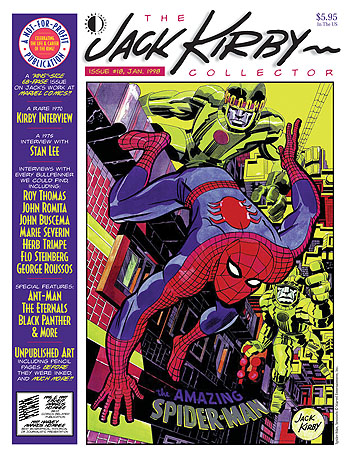
 Fischer’s solid ground is his use of Kirby’s Fourth World to refute the fascism charge.
Fischer’s solid ground is his use of Kirby’s Fourth World to refute the fascism charge.









